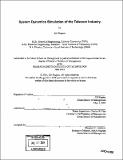System dynamics simulation of the telecom industry
Author(s)
Shapira, Gil, 1971-
DownloadFull printable version (6.737Mb)
Other Contributors
Sloan School of Management.
Advisor
Charles H. Fine.
Terms of use
Metadata
Show full item recordAbstract
The primary goal of this research effort was to integrate several pieces of relatively simple dynamics simulations into a full blown system dynamics simulation of the telecom industry. The economic simulation model was used to analyze potential dynamics, reaching basic qualitative insights on the forces behind the industry. Examples of the pieces which comprised the model include the product adoption life cycle, product substitution models, stochastic R&D investment models, as well as an economic model for determining market share under price competition. The work focused on key attributes and areas of the telecom industry, including network externalities, investment strategies, regulation, standardization of products, and behavior of consumer welfare. Main conclusions include the convexity of risk/return tradeoff in R&D investment under severe network externalities, as well as substitution as a matching device for innovation clockspeed in competing industries. Accordingly, it is shown that mismatch in innovation clockspeed, pricing clockspeed or product introduction timing may lead to an unsustainable competitive position. The work shows the advantages of R&D competition in driving consumer welfare. A theoretical framework has been put in place for considering the dynamic influence of regulation and standardization on investment incentives and choices. Through this framework, we can consider regulation and standardization effects in short-term and long-term, and how these correspond to the competitive stability of the industry.
Description
Thesis (S.M.)--Massachusetts Institute of Technology, Sloan School of Management, 2004. Includes bibliographical references.
Date issued
2004Department
Sloan School of ManagementPublisher
Massachusetts Institute of Technology
Keywords
Sloan School of Management.